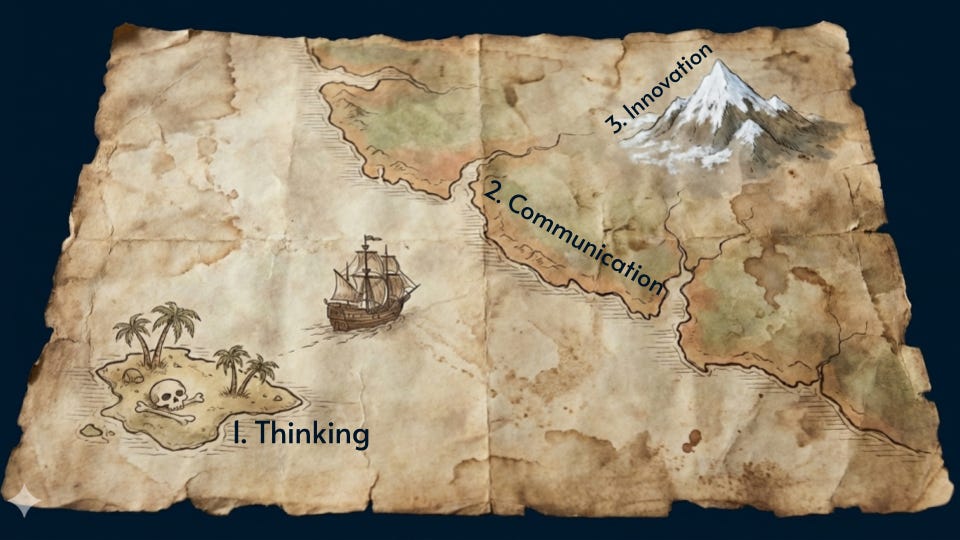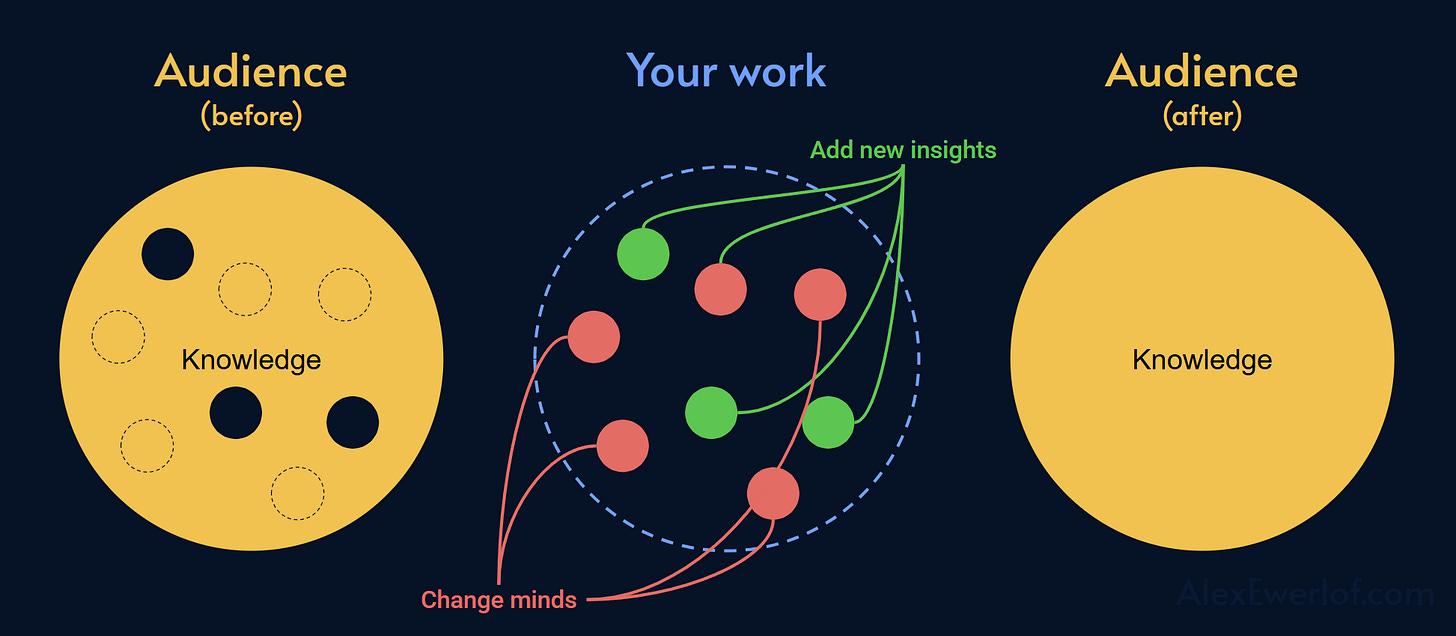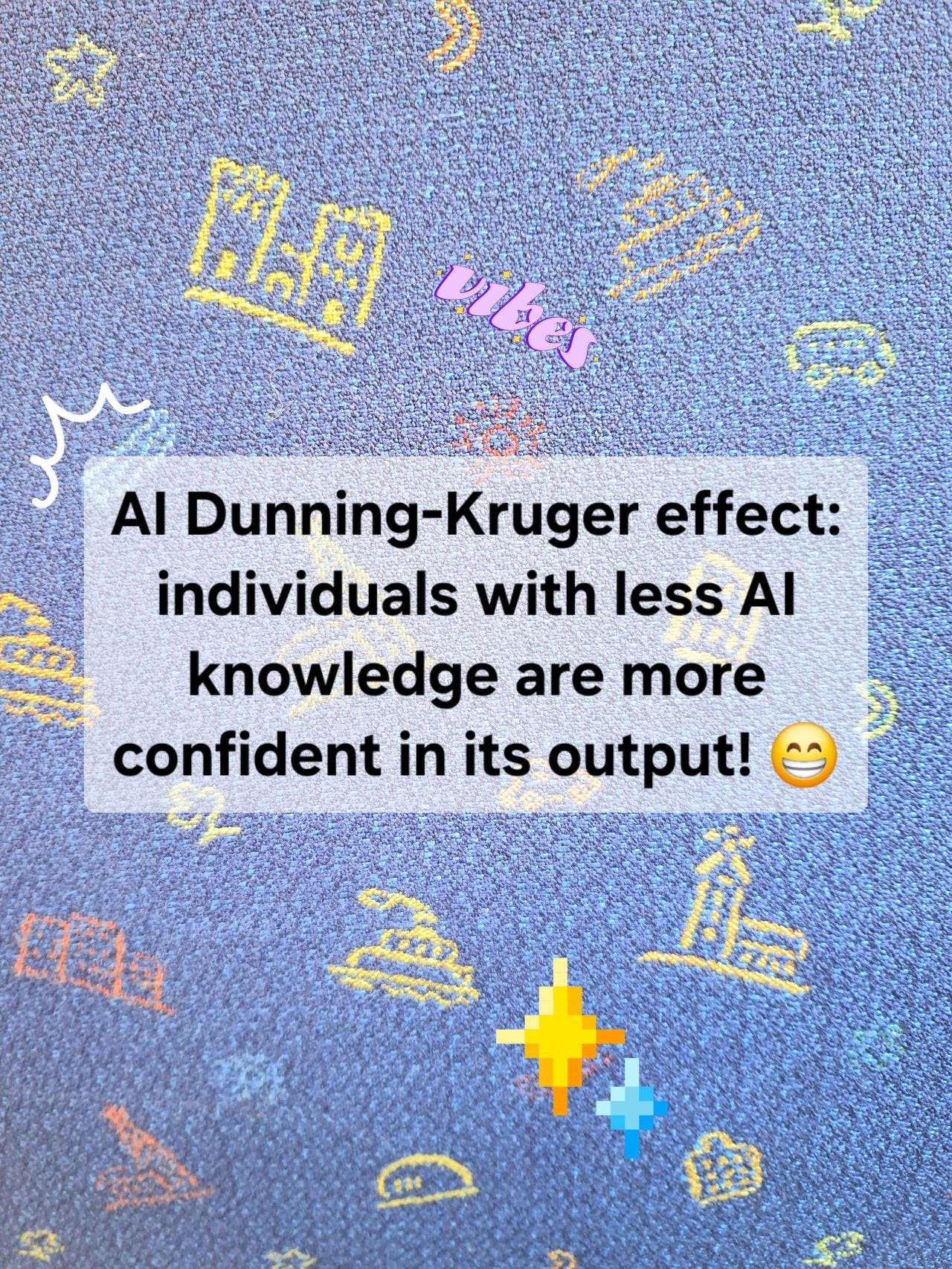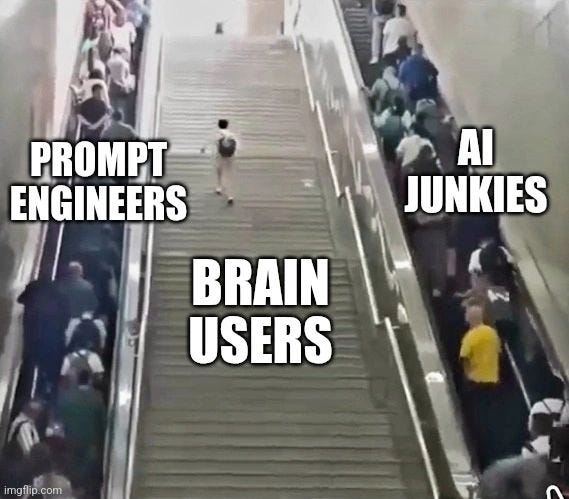3 levels of writing
A leveling model to use writing for thinking, communication, and innovation
For over 2 decades I’ve been writing publicly. Besides this newsletter and social media, I have my own book too.
Sometimes people ask my advice on writing. It happens enough to deserve its own section under the FAQ. It makes me sad when people say “I can’t write”. Because at its core writing is thinking. So all I hear is: “I can’t think”. 🤯
Before you get mad at me, allow me to elaborate.
In this post I formulate a skill leveling system, elaborate how AI changed my writing process and why writing is an even more relevant skill in the age of generative AI.
In my experience there are 3 levels of writing:
Thinking: you write primarily to organize your thoughts and reach clarity
Communication: you write to communicate your ideas
Innovation: you write to push the boundaries of the unknown
Your work may have elements from all 3 levels but there’s a clear distinction in intention, challenges and the skillsets you need to be aware of.
Level 1: Thinking
Writing is thinking.
Even if you don’t expose your words, the process of documenting them gets you closer to clarity.
It never stops amusing me when friends and colleagues ask my advice on writing. I am not particularly a good writer. English isn’t my mother tongue despite writing exclusively in this language. I have many typos and grammatical errors that are captured and corrected.
My writing process is basically a series of back and forth refinement. It’s a bit like how a sketch is shaped on a white paper from broad strokes to fine lines. And of course heavy usage of eraser. 😊
Iteration is the key.
Once you write your thoughts, you can step back and see it from a distance. Then you can refine the parts that don’t fit, reorder your thoughts to make it coherent, and remove the parts that don’t belong.
The more time you spend on this exercise, the clearer your thoughts.
At level 1, The audience is you.
The challenge is to think clearly and have the patience to refine it. Building this habit takes time, and in this era of rapid content consumption it’s harder than ever to find quality time and peace to reach clarity.
Clarity is powerful. Even more so in a messed up world. The ability to make sense of things, empowers you to tweak them to your benefit.
If you’re one of those people who says “I can’t write”, give yourself some credit and lower the bar.
You don’t need to be Shakespeare or Tolstoy to reach level 1. If you can think, you can write. And I don’t mean think straight, just think.
The goal of the level 1 is to use writing as a tool to reach clarity.
AI can polish the words but it cannot understand them for you. Your thoughts are very personal and until we reach Matrix level headjack, there’s no way around the slow, but rewarding process of reading, writing, and editing. 😄
That said, I use AI in level 1 to:
Do research (what others say about the topic?) and find knowledge gaps
Ask it to criticize my work and challenge my assumptions (a bit of hit and miss, since the current SOTA (state of the art) has difficulty with abstract concepts and reasoning)
Ask common questions (think next level “Googling”)
Ask for words in English that I cannot recall, or phrases that I want to use but am not sure about their meaning in my context.
Level 1 is brain-heavy and one of the major reasons that writing is still relevant in the age of AI-induced brain rot.
Level 2: Communication
After you reach clarity, you may want to share your best ideas with others as I’m doing here. 🎉
Just make sure that you don’t skip reaching clarity because an unclear result shows a confused thinker. Common symptoms to look out for:
Fancy words, acronyms and an overuse of polished images and diagrams. This is an effort to build a facade around ambiguity, subtly but surely making it the readers’ fault for not understanding.
Too much text, as if it was a brute force answer to an school assignment where the student hopes to get lucky and some of it makes sense. Or the reader just gives up thinking “if they wrote that long, they clearly know what they’re talking about”. 😄
Not a lot of feedback comes out of exposing such work because the audience either feels too stupid for not understanding it, or is too overwhelmed, or (if they have a choice) already distracted and moved on to something more engaging or important.
Writing for yourself (to reach clarity) is a very different exercise than writing as a medium of communication.
Typically, the bar for the quality and eloquence is set higher because you don’t want to be judged by your words in your absence.
But I’d argue that’s not the biggest challenge.
You see, if it takes W minutes to write something that is consumed by N people, each spending an average of R minutes to understand it, there’s a productivity equation at play:
It usually takes longer to write (W) than read and understand (R). If the audience spends more time reading your work than it took for you to write it (R > W), the productivity of the write-up is negative. Congratulations! You wasted other people’s time.
As we’ll discuss, this is becoming too common where the LLM is used as an expansion function on a prompt without even proof-reading the generated text. When using AI, W is the total time it takes to prompt, proofread, and edit.
When the audience is small (lower N), the only leverage you have is to spend more time in polishing and clarifying the write up (W) than it takes to read it (R). The shorter and crisper it is, the more productive it is (due to this part of the formula: W - R)
However, when the audience is large (higher N), any effort spent on improving the clarity and understandability of the write up, pays huge dividends due to the laws of scale (N). In these cases, you may want to “beta-test” the document by asking feedback from a closed group before going public.
Words are like bullets. Once they’re out, typically it’s hard to control their trajectory (how they are interpreted in your absence) and range (who will be exposed to them). The larger the potential audience, the more time needs to go into creating something that takes the absolute minimum amount of time to digest. You have a few levers and knobs:
Length: shorter is better
Tone: not a show-off
Complexity: build up in coherent steps
Illustrations (even memes)
Link to further reading: leave the irrelevant parts out
This is of course harder. A good method is to think about your target audience, what they may know, what you want to take away from reading, and how to build the appropriate bridge to connect the two.
Interestingly, AI can do a good job here. You can:
Assign a role (e.g., “You are an expert in SRE familiar with AWS Lambda and S3”) to set the knowledge base line
Feed your text to AI
Ask questions and see if AI’s response matches your truth
If your AI has internet access and grounding, you can ask it to find flaws in your argument and highlight alternatives based on what’s out in the public
This is a clever way to take advantage of AI’s limitations (hallucination, sycophancy, and prejudice) to emulate potential readers.
Just be aware of its other attributes (flawed reasoning, lack of abstract thinking and planning) when assessing the result. You’re not optimizing for AI, but for humans.
If you do optimize for AI “understanding”, your work can reach wider audience for example
Internal RAG tools like Copilot Studio
AI search engines like Perplexity
This increases N and consequently the productivity of your work depending if that’s what you want.
AI is a bar raiser, and not in a way that makes your job easier!
Powerful models are trained on a vast body of knowledge. Your audience faces a choice:
Do they want to have a dialogue with AI and get an answer that is 1) fit to their problem, 2) aggregates a large corpus of knowledge, 3) is more accessible (there are no stupid questions, “ELI5” or translate it to the audience language)
Or do they want to read your perspective which is shaped by your limited life trajectory?
They may prefer organic content (human-generated) to synthetic (machine-generated) because:
They appreciate originality that might be missing from the training data
They want to expand their knowledge from your real experience
They are after coherent opinions that fit together
something else
Whatever the reason, at least for now, there’s a market for genuine organic content but it also raises the bar: time and attention is an expensive resource. If someone decides to invest a few minutes to read organic content, you owe it to them to put your best forward and make it worth their time.
I really hope that you who read this far are convinced that you wouldn’t be able to prompt your way to these mental models in a timespan shorter than it took you to get here.
Level 2 requires skillful formatting, structure, tone-adjustment, and communication techniques.
I won’t repeat that here. Ask your favorite LLM or search online.
Instead I want to emphasize an important challenge for level 2 writing: getting attention in an increasingly busy world with decreasing attention span.
In the past, attention was cheap but content was expensive. Now it’s the other way around.
This makes content marketing even more important. It doesn’t matter that you’ve done a great job at level 2. If it doesn’t have reach, it’s not as productive.
Again, there are many techniques to maximize the N in the formula to reach relevant audience. I’ll leave that out to address the most mature level of writing. 👇
Level 3: Innovation
The highest level of this model is to add something to the body of the knowledge that didn’t exist.
It can be a new perspective, a new tool, or even pushing the boundaries of the unknown.
This is the realm of new books, scientific papers, and patents.
At this level, you’re not just explaining already-existing stuff in your voice. That is level 2 work. In level 3 you use your mastered voice to challenge assumptions, offer new perspectives, interpret data, inspire, create new mental models, and lead your audience to unfamiliar territory.
The time-span may range from here and now, to writing for the future generations.
The key difference between level 2 and 3 are depth of insight and mastery of influence toolbox.
At level 3, some of the advice from level 1 become irrelevant.
For example, a fictional book may intentionally use a wider vocabulary, or a scientific paper may intentionally use a sophisticated diagram because the topic demands that and the narrower audience can cope.
This is also how imposters try to sell a level 1 work as a level 2 or 3 😄. To the untrained eye, they look the same.
That is one reason AI is getting a lot of backlash these days: many people are genuinely annoyed that the AI generated text looks and sounds convincing. If you look carefully and have critical thinking glasses on, AI generated work has always been devoid of sharp insight due to how statistic models work.
Another giveaway is the generalizations and agreeableness, both of which stems from the pattern recognition algorithm behind the scene.
As someone who uses AI both for writing and coding, but also building LLM-powered products (like Local Browser AI or Service Level Assessment), I have developed an intuition for what is synthetic content, organic, or a hybrid. I can’t be the only one. And I’m not talking about em-dashes!
Recap
Building from level 1 to 3 takes years but the progression isn’t always linear.
Your writing may already be a mix of the 3 and you might be on your journey to do more level 3 work than level 1. Sometimes you need to return to level 1 when entering new domains.
But regardless of where you are, the path starts from level 1: you can’t explain it clearly if you haven’t reached clarity. And you cannot inspire others and change minds unless you have mastered communication.
The role of generative AI
I have already talked about AI in the 3 levels above but I like it deserves a dedicated section because in my observation, so much potential is being wasted expecting silicon brain to perform like carbon brain.
First, AI is here to stay. We should use AI very deliberately. Don’t exchange your long term growth for short term productivity.
In a world where everyone is busy rubbing AI all over their work, be the one who uses the brain.
Just like muscles, training the brain takes deliberate practice.
AI can help with research, adjusting the tone, and challenging your assumptions.
But make no mistake, there’s a strong value in doing things “by hand” for your own sake. You may choose to walk even if you have a car. It takes longer, but the long term health benefit is worth it.
Silicon brain has shown time and again that it can surpass the carbon brain: deep blue, AlfaGo, Watson, and many more to come as the massive investments on AI is bound to yield some results.
But that’s irrelevant. It’s not a competition.
In the era of mass produced, personalized, and “deeply faked” synthetic content, you’re going to need your brain in top shape.
Forget top shape.
Just maintain it in its current shape and you’ll be the smartest one: 😂

❌️ AI output is often lazy, low quality, and devoid of experience and opinion. You can prompt it to give it more character but that’s just next level faking.
✅️ Just like muscles, the brain gets stronger with training and usage. The most immediate danger of AI is not to take our jobs, it is to make us dumb!
✅️ Turn off the copilot to force yourself to think. Take the stairs whenever you can.
✅️ Use traditional search engines to find answers to other people’s problems and solutions because it expands your mind and exposes you to a wider range of ideas than the LLM would spoon-feed you.
✅️ Read books, blogs, etc. to learn how others solved the problems instead of relying on AI to much the collective wisdom to generate good looking solutions.
✅️ And most importantly, please please please don’t sell AI output as your work. Not only it’s deceptive and dishonest but those who are equipped with critical thinking and haven’t “parked their brains” see through it.
AI output is cheap. It’s the difference between a handcrafted carpet and a mass produced one by the machines.

You may think you’re acting smart using AI for efficiency but 1) a commodity is not an advantage, 2) what you’re doing to your brain is the equivalent of consuming ultra processed food!
Ironically as the quality of AI output increases, the ability to think critically and connecting to the human side of problem solving becomes even more important.
In the battle between the machines and the humans, always take sides with the humans. Humans follow humans, buy from humans, and build deep relationship with humans. There are always going to be anecdotal exceptions (like the Japanese woman who married with her AI lately) but I bet against that behavior going mainstream.
AI is a great tool. It helps get to results faster. It generates massive synthetic output at a fraction of the time it takes to produce that organically.
But when it comes to outcome, it needs a value system. And values are created by humans. AI can be trained to generate values, but AI is not us: its processing capacity isn’t limited by a skull, doesn’t have a body with our needs and desires. It may do a great job, but remember this:
We can immediately spot the problem because it’s visual and we’re very familiar with the “right” but this kind of error will continue to exists in synthetic output even if AI can think in abstract manner and find a solution to unify quantum mechanics and general relativity.
AI cannot be held accountable. Humans are.
You can scare the AI to be unplugged or punished, but even actually doing so doesn’t eliminate bad AI or fix its inherent “errors” due our fundamental differences.
AI overuse can cause long term damage to cognition, patience, and problem solving.
Your own work maybe isn’t as polished, quick, or agreeable. But that’s OK. I’ll pick that any day of the week over synthetic content because I can relate to and appreciate the effort.
If you choose to use AI, the bar should be higher. If you can spend 10 minutes to generate an output that would take you 2 hours, don’t sit and relax 1 hour and 50 minutes demanding the rewards for 2 hours!
AI is commodity now. When a tool is commodity, the brain is the differentiator.
Use that time to elevate the level of that work or deliver better quality or more work.
The price of your time is set by market economics not what was written in your pre-AI contract.
One final word: if you are neurodivergent, your perspective is important especially while everyone is trying to make AI more “normal”.
ADHD, OCD, Schizophrenic, Autistic, … Neurodivergence is not about being inferior. It’s about being wired differently.
All neurodivergent people have superpowers and challenges. It pays dividends to respect those challenges to capitalize those superpowers.
Difference adds perspective.
Just because people don’t have a flag on their head with a diagnosis, doesn’t mean it’s not there.
Everyone you meet is fighting a war you know nothing about. Be kind.
Everyone you meet has superpowers you know nothing about. Be respectful.
My monetization strategy is to give away most content for free but hese posts take anywhere from a few hours to a few days to draft, edit, research, illustrate, and publish. I pull these hours from my private time, vacation days and weekends. The simplest way to support this work is to like, subscribe and share it. If you really want to support me lifting our community, you can consider a paid subscription. If you want to save, you can get 20% off via this link. As a token of appreciation, subscribers get full access to the Pro-Tips sections and my online book Reliability Engineering Mindset. Your contribution also funds my open-source products like Service Level Calculator. You can also invite your friends to gain free access.
And to those of you who support me already, thank you for sponsoring this content for the others. 🙌 If you have questions or feedback, or you want me to dig deeper into something, please let me know in the comments.










